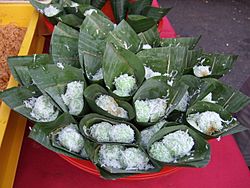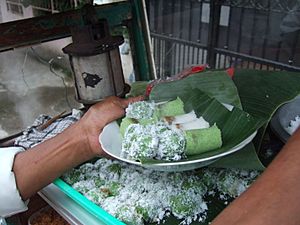Klepon facts for kids

Klepon wrapped in banana leaf container
|
|
| Alternative names | Onde-Onde (Brunei, Malaysia, Singapore) |
|---|---|
| Type | Snack |
| Place of origin | Indonesia |
| Region or state | Java |
| Associated national cuisine | Indonesia, Brunei, Malaysia and Singapore |
| Main ingredients | Rice cake, palm sugar (gula jawa/merah/melaka), grated coconut |
| Variations | Rainbow Kelepon |
Klepon (pronounced Klē-pon) is a yummy snack from Indonesia. It's a sweet ball made of rice cake, filled with melted palm sugar, and covered in grated coconut. These green, chewy balls are a popular traditional treat called kue in Indonesian cuisine. They come from Java, an island in Indonesia.
Contents
Making Klepon: Ingredients and Steps
Klepon is a boiled rice cake. It is stuffed with sweet, liquid palm sugar. Then it is covered in shredded coconut.
What Klepon is Made Of
The dough for klepon is made from sticky rice flour. Sometimes, a little tapioca is added. The dough gets its green color from a special paste. This paste comes from the leaves of the pandan or dracaena plants. These leaves are often used in Southeast Asian cooking.
How Klepon is Cooked
First, small pieces of solid palm sugar are placed inside the sticky rice dough. The dough is then rolled into small balls. These balls are boiled in water. As they boil, the palm sugar inside melts. This creates a sweet, liquid center. It takes skill to make sure the liquid sugar stays inside!
After boiling, the warm balls are rolled in shredded coconut. The sticky surface of the rice dough helps the coconut stick. Klepon tastes best when it has cooled down a bit. This stops you from burning your mouth on the hot liquid sugar. They are often served on banana leaves, usually in groups of four or ten. Today, you might also find them in plastic packaging.
The Many Names of Klepon

Klepon is the Javanese name for these sweet rice balls. In other parts of Indonesia, like Sulawesi and Sumatra, and in nearby Malaysia, it is often called onde-onde. This can be confusing! In Java, onde-onde refers to a different Chinese snack. That snack is a rice ball covered in sesame seeds and filled with sweet green bean paste.
Some people also call it 'buah melaka', which means 'Malaccan fruit'. But in Java, if you call klepon onde-onde, people will tell you it's wrong! Klepon truly comes from Java. Its history and how it spread show this.
Klepon in the Netherlands
Klepon is also popular in the Netherlands. This is because of the historical ties between the Netherlands and Java. In the 1950s, people from Indonesia who moved to the Netherlands brought klepon with them. You can easily find it in special shops called toko shops. You can also find it in Dutch or Chinese Indonesian restaurants and supermarkets there.
In Java, klepon is a common snack. People often eat it in the morning or afternoon. It is sold in traditional markets and villages as jajan pasar (market snack). In cities, it's known as kue basah (moist kue).
Different Kinds of Klepon and Similar Snacks

Traditional klepon looks pretty much the same in Indonesia, Malaysia, and Singapore. But new versions have been made! Some modern klepon use yam or sweet potato dough instead of rice flour. Others might have chocolate filling instead of palm sugar. Some even use grated cheddar cheese instead of coconut!
Colorful klepon has also been created. These often use potato dough and food coloring. This makes them look even more fun for kids.
Klepon vs. Kue Putu
Klepon is quite similar to another snack called Kue putu. The main differences are their shape, texture, and the type of flour used. Klepon uses sticky rice flour and is chewy, a bit like mochi. Kue putu uses regular rice flour and is soft and crumbly, like a cake. Klepon is shaped into balls. Kue putu is tubular, made using a hollow bamboo tube as a mold.
Recently, people have even combined baking cupcakes with klepon ingredients. In India, there's a snack called paan ladoo that looks like klepon, but it uses different ingredients.
See also
 In Spanish: Klepon para niños
In Spanish: Klepon para niños

